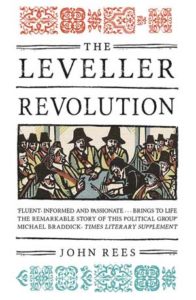The Leveller Revolution: Radical Political Organisation in England, 1640–1650
Reviewed by Brian Drayton
October 1, 2018
 By John Rees. Verso, 2016. 512 pages. $34.95/hardcover; $19.95/paperback; $9.99/eBook.
By John Rees. Verso, 2016. 512 pages. $34.95/hardcover; $19.95/paperback; $9.99/eBook.
Some Friends hold that the first generation of Quakers belong to so radically different a time and culture that they are not really relevant to us, and that an attempt to understand the spirit in which they lived and gave forth the writings and revelations that we have inherited is a distraction from today’s work. But “all of us who bear the name ‘Friend’” thereby claim some inheritance from that generation, and that era; an inquiry into their ideas and their times can bring insight into the nature of that inheritance and our share in it. What we do with the knowledge is then another thing. I am happy to recommend John Rees’s big book on the Levellers, which is perhaps all the more interesting now, as many of us are seeking to be more challenging and less collaborationist with the powers that be.
The Levellers were one among many striving, creative movements arising during the English Revolution. Quakers tend to hear mostly about John Lilburne, perhaps the most influential voice of the movement, but as Rees unfolds the tale, we hear of many stalwarts like Katherine Chidley, and the numerous temporary allies who joined (and debated) with Lilburne in making a decisive contribution to the revolution of the 1640s. Though there were, as with early Quakerism, some members of the upper classes (whether by money or birth) who sympathized with or actively joined the movement, the strength was drawn from dissenters of “the middling sort”—merchants and craftspeople. Unlike early Quakerism, the Levellers’ center of gravity from the beginning was London, already the great mixing bowl for ideas from across England.
It is hard to say when the waves of unrest that resulted in the Revolution began—you could start with Elizabethan times—but Rees shows us that by the 1630s, various streams of dissatisfaction were converging. For one, there were those resisting the strict control exerted by the bishops on the cultural life of the country: Not only did they place restrictions on worship, behavior, and other “values” issues, they also exerted strict censorship on what ideas and authors could be published. Another source of unrest was the vast population of apprentices in London. Perhaps as much as 20 percent of the population consisted of young people bound under strict labor agreements, but who had opportunity to associate with each other in various venues, including brothels and taverns (important meeting places for the respectable as well as the raffish—one of the early Friends meetings in London was at the Bull and Mouth). Finally, there were the many kinds of religious dissenters. John Lilburne, already a dissenter, came to London as an apprentice, and undertook his first public protest actions in support of William Prynne and others who were imprisoned for opposing the bishops’ hegemony. Lilburne was early distinguished for his military service in the parliamentary cause. The New Model Army itself was a powerful incubator of dissenters, including many early Quaker leaders.
The levelling ideas centered around the dignity of the individual and the belief that the people were an independent, and in some sense foundational, power in the land for whose benefit princes ruled and whose rights of conscience, of a just livelihood and participation in governance were rooted in natural law, reason, and the precepts of the Gospel. Thomas Rainsborough, a noble Leveller, wrote:
For really I thinke that the poorest hee that is in England hath a life to live as the greatest he; and therefore truly, Sir, I thinke itt’s cleare, that every man that is to live under a Government ought first by his owne consent to putt himself under that Government; and I doe thinke that the poorest man in England is nott att all bound in a strict sense to that government that he hath not had a voice to put himself under.
By the 1640s, the Levellers were a recognizable movement that made creative use of street protests and of petitions (Rees’s account is filled with a dizzying number of petitions and remonstrances), usually coordinated around a specific issue—a dissenter’s imprisonment, an unjust magistrate, an onerous fee or tax. “Agitators” or other correspondents were established in neighborhoods, army units, and other social groupings to build awareness of issues and ideas, spread literature, cultivate allies, and communicate with each other about plans, campaigns, and opportunities.
With the execution of Charles I and the installation of the Protectorate, the Levellers became a problem to the new regime. Lilburne and other leading voices were imprisoned or otherwise persecuted; publications were suppressed. Some supporters found that the Revolution had accomplished enough and were inclined to accept the new status quo. By 1650, the Levellers were a spent force. Still, they had pushed the Revolution to the left, until “victory” created a new establishment.
At that point, their pressure triggered a reactionary or conservative backlash, as Oliver Cromwell tried to constrain the forces of transformation. All this was swirling around those who became the first Friends, and many of the “tender people” they first recruited had been touched more or less deeply by the “levelling tendency.” What does it say about these first Friends that after Lilburne the steadfast was released at last from prison, he became for his last few years a Quaker?



Comments on Friendsjournal.org may be used in the Forum of the print magazine and may be edited for length and clarity.